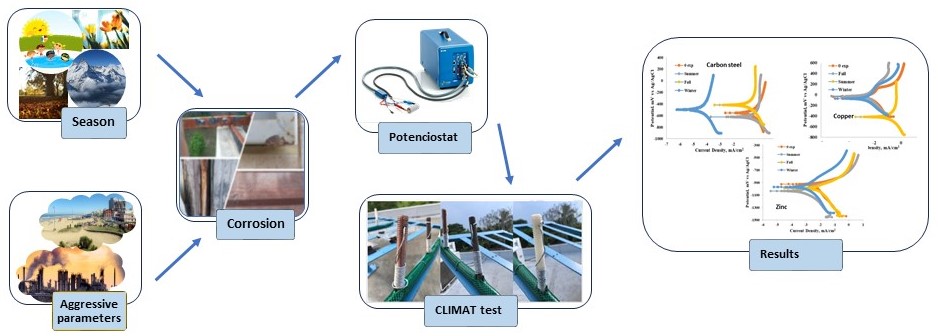Weather Conditions, Corrosivity Indexes and Electrochemical Corrosion of Carbon Steel, Copper and Zinc in the Coastal Atmosphere of Tuxpan, Veracruz, Mexico
DOI:
https://doi.org/10.29356/jmcs.v67i4.2041Keywords:
Corrosion, CLIMAT, corrosivity indexes, electrochemical impedanceAbstract
Abstract. Tuxpan is a port with economic and industrial important activity subject to atmospheric corrosion of metal structures such as boats, ships, oil platforms, and power stations. The main purpose of this paper is to evaluate the atmospheric corrosion of Tuxpan Veracruz, it was necessary to install an exposition panel with carbon steel specimens, galvanized steel (zinc), and copper to evaluate them in every season by electrochemical methods (electrochemical impedance spectroscopy (EIS), linear polarization resistance (LPR) and potentiodynamic polarization curves (CP). In addition, corrosivity indexes of atmospheric are evaluated by CLIMAT and ISO methodology. An exposition panel was installed with specimens of aluminum wire on steel screws, copper screws, and nylon screws to study corrosivity indexes through mass loss in every season of the year and thus classify the different types of atmospheres; marine, industrial, and rural-urban according to the values specified in the standard (ISO 8408, 9223, 9224). The corrosivity indexes are under the standards allowed in the regulations. However, they show the aggressiveness of the marine and industrial atmosphere due to the location and activities of the port in the northern zone. Zinc and carbon steel corrodes due to aggressive agents such as chlorides and sulfur dioxide, forming soluble oxides on the surface of the metallic substrate, while copper forms corrosion products that weakly protect its surface.
Resumen. Tuxpan es un puerto con importante actividad económica e industrial, ha sido objeto del proceso de corrosión atmosférica en las estructuras metálicas como embarcaciones, botes, plataformas petroleras y Termoeléctricas. El propósito principal de este trabajo es evaluar la corrosión atmosférica de Tuxpan Veracruz, se instaló un panel de exposición con probetas de acero al carbono, acero galvanizado (zinc) y cobre para poder evaluarlas en cada estación del año por métodos electroquímicos (impedancia electroquímica espectroscopia (EIE), resistencia de polarización lineal (Rp) y curvas de polarización potenciodinámicas (CP). Además, se evalúan los índices de corrosividad de la atmósfera mediante la metodología CLIMAT e ISO. Se instaló un panel de exposición con probetas de alambre de aluminio sobre tornillos de acero, tornillos de cobre y tornillos de plástico para estudiar los índices de corrosividad por pérdida de masa en cada estación del año, y así clasificar los diferentes tipos de atmósferas: marina, industrial y rural-urbana según los valores especificados en la norma (ISO 8408, 9223, 9224). Los índices se encuentran por debajo de los estándares permitidos en la normatividad. Sin embargo, muestran la agresividad del ambiente marino e industrial producto de la ubicación y actividades del puerto en la zona norte. El zinc y el acero al carbono se corroen debido a agentes agresivos como los cloruros y el dióxido de azufre, formando óxidos solubles en la superficie del sustrato metálico, mientras que el cobre forma productos de corrosión que protegen débilmente su superficie.
Downloads
References
Gallardo E.; Lugo G.; Galicia A.; Ramírez J. L.; Mercado I. G.; Molina L. A.; García N.; Pérez J. ECS Transaction. 2015, 64, 55-62. DOI 10.1149/06427.0055ecst. DOI: https://doi.org/10.1149/06427.0055ecst
Rosas M. A.; Gallardo E.; Lugo G.; Galicia A.; Ramírez J. L.; García N.; Pérez J.; Oseguera J. S. ECS Transaction. 2015, 64, 135-140. DOI 10.1149/06426.0135ecst. DOI: https://doi.org/10.1149/06426.0135ecst
Lugo G.; Gallardo E.; García N.; Ramírez J. L.; Galicia G.; Flores L. M.; Pérez J.; Ibáñez J. G.; Oseguera J. S. ECS Transaction. 2017, 76, 61-67. DOI:10.1149/07601.0061ecst. DOI: https://doi.org/10.1149/07601.0061ecst
Genesca, L. J.; Mariaca R. L.; Uruchurtu J.; Salvador L., in: Corrosividad atmosférica (MICAT-México). Ed., Plaza y Valdés, México D. F., 1999. 34-131.
ISO 8407. Corrosion of metals and alloys. Removal of corrosion products from corrosion test specimens, 1991.
ISO/DP 9223. Corrosion of metals and alloys. Classification of Corrosivity Categories of atmospheres, 1986.
ASMT, G59-97. Standard Test Method for Conducting Potentiodynamic Polarization Resistance Measurements, 2010.
Morcillo M., in: Corrosión y protección de metales en las atmósferas de Ibero América; Mapas
de Iberoamérica de Corrosión Atmosférica. Barcelona: Ed., Bellaterra S.A. 1982.
Ramírez, J. L.; Uruchurtu J., in: Métodos Experimentales en la ciencia de la Corrosión. Ed., Académica Española, Veracruz, México. 2011.
Roberge, P. R., in: Handbook of Corrosion Engineering. Ed., McGraw-Hill. New York, USA. 2000.
Calvert, J.G., in: Kinetic studies of sulfite oxidation in aqueous solution in SO2, NO and NO2 Oxidation Mechanism: Atmospheric Considerations. Ed., Butterworth, Boston, Woburn, MA. 1984.


Downloads
Published
Issue
Section
License
Copyright (c) 2023 E. Gallardo-Castán, G. Lugo-Islas, N. García-Navarro, J. G. Ibañez Cornejo, G. Galicia Aguilar, J. L. Ramírez Reyes

This work is licensed under a Creative Commons Attribution-NonCommercial 4.0 International License.
Authors who publish with this journal agree to the following terms:
- Authors retain copyright and grant the journal right of first publication with the work simultaneously licensed under a Creative Commons Attribution License that allows others to share the work with an acknowledgement of the work's authorship and initial publication in this journal.
- Authors are able to enter into separate, additional contractual arrangements for the non-exclusive distribution of the journal's published version of the work (e.g., post it to an institutional repository or publish it in a book), with an acknowledgement of its initial publication in this journal.









